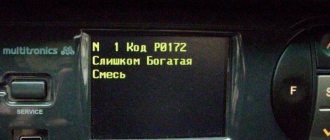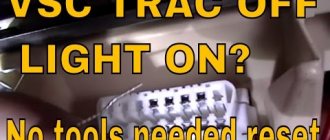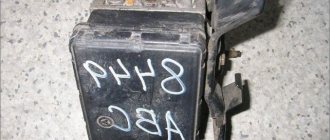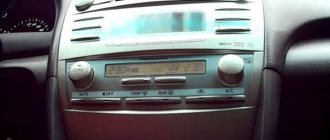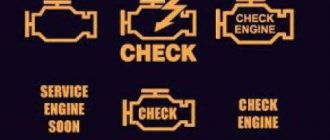Error P0810 on the “robot” Toyota Corolla occurs when the clutch position control system malfunctions. There are some other reasons that contribute to the appearance of such code. Programs running on the OBD-2 scanner display this error in English.
Error P0810 appears when the Toyota Corolla robot malfunctions.
General information about error P0810 in Toyota Corolla: description of the problem
If a diagnostic system equipped with an OBD-2 scanner displays the specified code, it means that the transmission control unit has detected a malfunction of the clutch. The error occurs only on vehicles with a manual transmission (gearbox). The powertrain control module (PCM) controls the functions of this unit.
Changing the position of the shift knob and clutch pedal is one of these actions. In some Toyota models, the PCM monitors the condition of the turbine and, based on its rotation speed, determines the severity of clutch slippage.
The clutch is a small part that connects the gearbox to the engine. After pressing the main cylinder, a special liquid enters the working part of the system. The latter moves the clutch pressure circle. The engine is connected to or disconnected from the transmission as necessary.
The main function of the clutch switch is to ensure safety. If the position of the gearshift knob is accidentally changed, the engine will not start. The PCM and associated controllers use data from the clutch system to calculate engine operating parameters. If a malfunction is detected in the components discussed above, the diagnostic unit stores error P0810. At the same time, the MIL indicator turns on. Most often, the lamp lights up after several attempts to turn on the ignition.
Symptoms of a problem
The backlight of the MIL indicator is the main symptom of a breakdown. This lamp is also called Engine Check or “Check”. Other signs of malfunction include:
- Problems starting the engine.
- The warning light on the dashboard comes on. The code is stored in memory as a fault.
- Refusal to start the engine even when the clutch pedal is fully pressed.
If the Engine Check light is illuminated, it is a sign of a problem.
Sometimes there are no signs of breakdown at all. If the fault persists for a long time, it impairs the function of some vehicle parts, such as traction and safety systems.
Therefore, experts consider P0810 a significant error that must be addressed immediately.
Modern scanners
Reading Corolla fault codes with scanners not only simplifies self-monitoring, but also makes it more informative. Today, manufacturers of diagnostic car scanners supply the market with a wide range of them, differing both in functionality and price. On the one hand, such a market is capable of satisfying the needs of various segments of consumers, but on the other hand, it creates certain difficulties, since it requires some special knowledge when purchasing. Here we will only indicate the main types of diagnostic equipment, as well as its purpose. And this will not be a bad guideline for choosing the right scanner. Based on functionality, scanners are distinguished between dealer, brand and multi-brand.
Corolla robot error codes
Dealer scanners are produced by automakers or their contractors, usually for a specific car brand. They have a wide range of functionality and are intended for professional use, and the price can reach several thousand dollars.
The group of brand scanners is also intended for professional use. They have functionality similar to that of the dealer, but more modest. The price of branded scanners ranges from several hundred to a thousand dollars.
Fault codes for automatic transmission and ABS Corolla
Multi-brand scanners are most widespread among motorists. They are easy to use and provide sufficient information for most situations. Scanners of this group are unified for several car brands. Therefore, when purchasing, you need to check their ability to read Corolla error codes.
Error codes for Corolla with VSC system
Causes
The code appears against the background of the following problems:
- breakdown of the clutch position controller;
- incorrect switch adjustment;
- broken cables, short circuit, dirty contacts in the electrical circuit of the clutch sensor;
- problems with conducting electricity in the circuit;
- blown fuse or fuse;
- malfunction of the PCM or other control system elements;
- software obsolescence.
The code appears due to a breakdown of the Toyota Corolla controller.
Two-digit system codes
Powertrain fault codes
Decoding engine fault codes for type 09:
11 — lack of power supply to the valve control unit; 12 and 13 - no engine speed signal is received; 14 - no feedback is received from the negative contact of the ignition coil or, if there are two of them, then from coil No. 1; 15 - no feedback from the negative contact of ignition coil No. 2; 16 - no signal is received from the automatic transmission ECU; 17 and 18 - unacceptable value of camshaft position No. 1 and No. 2; 21 — incorrect signal from the oxygen level sensor; 22 - unacceptable temperature value of the power unit; 23 and 24 - incorrect indicator of intake air temperature; 25 — lean air-fuel mixture; 26 - too rich air-fuel mixture; 27, 28 and 29 - incorrect signal from the additional oxygen sensor; 31 — unacceptable value of air flow or pressure of the intake manifold; 32 — incorrect response of the air flow sensor; 34 — boost malfunction; 35 — unacceptable value of intake manifold pressure (vacuum sensor); 38 - incorrect signal from the fluid sensor in the automatic transmission; 41 — incorrect response of the throttle position sensor; 42 - unacceptable value of the speed that the car develops; 43 - lack of starter signal on the engine ECU; 46 - malfunction of solenoid valve No. 4 or its circuit; 47 - breakdown of the additional sensor that fixes the position of the throttle or its circuit; 48 — malfunction of the additional fuel supply system; 51 - there is no idle signal from the sensor displaying the throttle position; 52 and 55 - incorrect feedback from the knock sensor; 53 - failure of the knock sensor control circuits; 61 - malfunction of the speed sensor and its circuit; 62-65 - malfunction of solenoid valves No. 1-4 or the corresponding circuit; 67 - malfunction of the O/D switching sensors or its circuit; 71 — breakdown of the exhaust gas recirculation system; 72 - malfunction of the fuel cut-off solenoid; 77 - malfunction of the pressure control solenoid or its circuit (in automatic transmission); 78 - there is no signal from the fuel pump or a malfunction of its circuits; 81—85 — malfunction of circuits in various parts of the robot box; 86 - breakdown of sensors that record engine speed; 88 - malfunction of the electrical circuit between the power plant control units and the automatic transmission; 89 — malfunction of the electrical circuit between the power plant control units and the robot box; 99 - no faults. Decoding engine fault codes for type 10: 1 - normal operation; 2 — unacceptable air flow value; 3 — incorrect switch signal; 4 - unacceptable antifreeze temperature value; 5 — incorrect oxygen sensor signal; 6 — unacceptable engine speed; 7 — incorrect response of the throttle position sensor; 8 — invalid air temperature sensor signal; 9 — incorrect signal from the sensor recording the vehicle speed; 10 — there is no signal to turn on the starter; 11 - breakdown of the air conditioner or position N in the automatic transmission.
Error codes for ABS and TRC systems (code 10)
11 — presence of an open circuit in the solenoid relay; 12 - solenoid relay circuit closed; 13 — presence of an open circuit in the pump motor control relay; 14 — circuit closure of the pump motor control relay; 15—18 — presence of disturbances in the operation of the TRC solenoid control; 21—24 — violation of the wheel solenoid circuit; 25—27 — violation of the TRC solenoid circuit in different parts of the circuit; 31—34 — incorrect signal from wheel speed sensors; 35 and 36 - open circuit of wheel speed sensors; 37 - malfunction of the rotors installed on the sensors displaying the speed of the rear wheels; 41 — too high or low supply voltage; 43 - deviation in the operation of the deceleration sensor; 44 - malfunction of the deceleration or neutral sensor circuits; 45-49; 58 and 61 - breaks and malfunctions of TRS circuits and parts; 51—53 — malfunction of the pump electric motor or its control; 55 - low brake fluid level or malfunction of its sensor; 56 and 57 - unacceptable oil pressure value; 62 — incorrect operation of the engine speed sensors; 71—74 — reduced voltage of wheel speed sensors; 75—78 — unstable signal from wheel speed sensors; 79 - deviation in the operation of the deceleration sensor or its circuit.
Diagnostic methods
To identify possible causes of the code, perform the following procedures:
- Inspect the cables for breaks, insulation damage, and short circuits. If there are abrasions and other defects, you need to prepare to replace the wiring.
- Clear the control module of all error codes. After this, restart the engine and use the car for its intended purpose. You need to see if the specified combination of characters occurs again.
- Check the clutch controller and replace the part if any faults are found.
- Inspect the fusible strip or fuse for burnout.
- Check whether the diagnostic module software is outdated.
Additionally, the battery is tested under load and the cable connections are inspected. Measure the power of the generator. You need to find the diagnostic port, connect the scanner, read all the saved information and codes.
All information needs to be written down, it will help with further repairs. Before the test drive, all combinations are removed.
Voltage check
To identify a breakdown, you need to measure the voltage on the input circuit of the clutch position controller. If the parameter is different from 0, press the pedal. After this, the voltage on the output line is measured. When the parameter is 0, the sensor is faulty. When there is voltage on all circuits, you need to check the PCM connection location. The absence of a signal indicates that the programs are outdated. It is recommended to disable all associated elements. A multimeter is used to measure cable resistance. If necessary, replace closed areas.
To identify a breakdown, measure the circuit voltage.
The fuses must be checked with the clutch pedal depressed. Parts that appear normal may be faulty. They fail when the load increases. Trouble code P0810 can occur when the pedal bushing or clutch lever is worn.
Types of two-digit codes
For self-diagnosis of cars, two types of two-digit codes are most often used: the first is type 09; the second is type 10.
You can determine what type your car supports and whether there are any recorded errors in its operation as follows:
Frequent and continuous flashing of the warning light, when the flash and pause last for 0.5 seconds each, indicates that the vehicle is using type code 09. If when using this code the light flashes more than 11 times, then no fault records were detected.
When using codes of the second type, the light blinks at intervals of varying durations. The absence of faults during self-diagnosis is indicated by continuous flashing at intervals of 4.5 seconds. An example of reading codes of this type: flash - pause - flash - long pause - flash - this is code 21.
Nuances of troubleshooting
If an error occurs when installing a new assembled drive, you need to adjust the fastenings of the mechanism. Otherwise, you will not be able to reset the code. When replacing the clutch position controller, you must correctly configure the electronic elements of the transmission system. If this does not help, the lamp does not go out, you will have to replace:
- TCM system (transmission control unit);
- sensors, fuses, fuses;
- damaged sections of the electrical circuit;
- software.
OBD standard codes
Some Toyota Corolla cars support the OBD standard, which provides for error indication using 5-digit codes: one alphabetic character and four numeric ones.
The first character of this code is called the Alpha pointer and indicates the system in which the fault occurred:
- P - engine or transmission;
- B - car body;
- C - suspension;
- U is a network system.
The following numbers indicate the exact location and classification of the problem.
To diagnose problems in cars that support this protocol, it is recommended to use special scanners, testers, or connect to a PC using special programs.
Useful tips for car owners
To prevent the code from appearing in the future, when operating a car with a robotic gearbox, you need to take into account the following nuances:
- Do not press the gas pedal sharply. A calm driving style is considered the best. If driving is necessary, press the pedal smoothly. Acceleration is performed manually, braking is automatic.
- A feature of the “robot” is the appearance of shocks when switching the gearshift knob. Reducing the speed of the power unit eliminates this problem.
- Manual mode helps push the car out of a snowdrift by rocking. However, you cannot skid in a car with a “robot”. This reduces the service life of the gearbox several times.
Regular maintenance should be complemented by a complete transmission diagnostic. This helps identify significant problems in a timely manner.
Actions to take when an error occurs
What to do if the check engine light or another system light comes on? If errors occur in the climate control, airbag, battery, actuator or internal combustion engine, a reset should be performed after diagnostics: for this you can use a scanner or perform electrical manipulations.
Resetting the error for a Corolla 150, Toyota Corolla E120 or another modification of any year of manufacture is carried out according to one algorithm: you can turn on the ignition, press the brake pedal several times, and then repeat the procedure with the ignition off.
When diagnosing an E150 or Corolla E120 model for errors with a scanner, a reset can be performed quickly with just a few button presses.
What to do if the check engine light is on
- Low-quality fuel: get rid of such fuel and fill your Toyota Corolla with gasoline with a higher octane rating.
- Coil failure, no spark, faulty spark plugs: the damaged element must be replaced.
- Dirty injectors: clean.
- Working with intermittent lambda probe, catalyst: replacement.
- The need to check the mesh on the gasoline pump: check the gasoline supply pressure, it should not be lower than 3 atmospheres. If lower, carry out repair work.
- Inadequate oil level: Listen to the engine when it is warm. If there are extraneous noises, it's time for repairs.
[flat_ab >
The indicator indicators will help you carry out self-diagnosis of your Toyota Corolla, and special error codes will indicate a specific problem and then you can decide where and how to fix it. If the manipulations to find out the reason for the indicator light are not clear to you, you can always contact the service center.
Work process
The mechanism works as follows: The rotating shaft of the electric motor transmits torque to the gearbox, consisting of the crown gear of the shaft rotation lever, the gear shift shaft and the selection lever, thus displacing them, as a result, through the lever rod to a special gear shift fork rod, resulting in a Toyota actuator The Corolla shifts to the desired gear.
Checking the brushes on the actuator motor
So, the question arises: how to check whether the problem is really in the brushes? The answer is very simple. First we need to remove the servo itself. It's not difficult to do this. First we need to lift the hood of the car and disconnect the battery terminals. The second step is to remove the battery itself and begin to unscrew the platform on which it was located. This is not difficult to do, since it is secured with only four bolts. Having unscrewed it, we take it out - here we have a view of the part we need - the clutch actuator. In the photo below you can see what it looks like from above.
Location and types of diagnostic connectors
Cars of the Japanese manufacturer Toyota were equipped with two types of connectors that allow diagnostics - DLC1 and DLC2. More modern models use a DLC3 connector (standard OBD-II).
DLC1 is made in the form of a rectangle located on the left side of the engine compartment (in most cars of this brand). The plastic cover of this connector is marked Diagnostic.
Toyota errors can manifest themselves as follows:
The DLC2 diagnostic connector in almost all cars of this manufacturer is located under the dashboard on the driver's side. Outwardly it differs from the first one. One of the features of this connector is the ability to diagnose a car on the go.
In earlier Toyota models, the diagnostic connector is located in the engine compartment. Typically, it is round in shape and yellow in color. It can often be found near the battery.
Engine self-diagnosis
When operating Toyota cars in Russia in difficult climatic conditions, various engine problems often arise. These could be either serious breakdowns, which will be quite difficult to fix and it will be easier to install a contract engine, or failure of any sensors. If your “Check Engine” light comes on, don’t rush to get upset right away. First you need to carry out a simple self-diagnosis of the Toyota engine. This procedure will not take much time and will help you identify problems in the engine.
Conclusion
Computer diagnostics of a Toyota Corolla E150, 120 or other modification for most modern cars is performed through the OBD II connector, and during the test the device can show a code with the index P, which indicates the presence of problems. When such errors appear, it makes sense to check the engine of a Toyota Corolla released in 2008 or later, and conduct a detailed check of the condition of the gearbox, clutch, electrical system or other system, depending on the specific code. The error is reset after the problem is detected and corrected; cleaning is done by issuing a command from the scanner or resetting the terminal: in the first case, the result will appear instantly.


